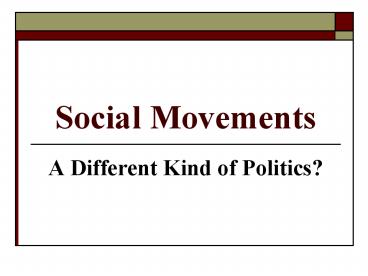Social Movements - PowerPoint PPT Presentation
1 / 24
Title:
Social Movements
Description:
della Porta, Donatelli and Diani, Mario (1999) Social Movements: An Introduction ... 3. TACTICS: NVDA (Greenpeace, Brent Spar) 4. MEMBERS. Byrne: separation of ... – PowerPoint PPT presentation
Number of Views:183
Avg rating:3.0/5.0
Title: Social Movements
1
Social Movements
- A Different Kind of Politics?
2
Examples
- THE STUDENT MOVEMENT
- THE WOMENS MOVEMENT
- THE PEACE MOVEMENT
- THE ECOLOGIST MOVEMENT
- THE ENVIRONMENTAL MOVEMENT
- ANTI-CAPITALIST MOVEMENT
- ANTI-POVERTY MOVEMENT
3
Structure of Lectures
- Defining the term social movement
- The basic/defining characteristics
- Theoretical approaches How do we explain rise
and development? - New social movements
- Areas of contention
- The impact of social movements
4
Additional Reading
- della Porta, Donatelli and Diani, Mario (1999)
Social Movements An Introduction (Oxford
Blackwell). - Scott, Allan (1995) Ideology and the New Social
Movements (London Routledge). - Wilkinson, Paul (1971) Social Movement (London
MacMillan).
5
Introduction
- Rise in interest in social movements
- Common theme is that social movements are
different - See Byrne
6
Byrne 1997 9
- Alongside the normal avenues of political
participation parties, protectional interest
groups and even promotional pressure groups we
have a new form of political action, social
movements.
7
Byrne cont.
- These movements have radical aims which question
some of the core ideals associated with advanced
industrial democracies. The motives of their
supporters, and the ways in which they pursue
these aims, seem to be significantly different
from those found in mainstream politics.
8
Wilkinson 1971
- extraordinary confusion and difficulty
- complete absence of consensus
- Central feature SMs committed to radical changes
in society - Built on Heberle 1951 emphasis on change in
social and political order - Associated with democracy
9
DEFINING CHARACTERISTICS
- 1. ORGANISATION
- 2. IDEOLOGY/ AIMS
- 3. TACTICS NVDA (Greenpeace, Brent Spar)
- 4. MEMBERS
10
Byrne separation of
- political parties (formal political organisations
that participate in elections) - protectional interest groups (groups that protect
interests of members e.g. tus and professional
assocs) - promotional interest groups (groups that campaign
for a general cause e.g. anti-poverty groups or
animal groups) - social movements (which include many
organisations or groups, such as the
environmental movement) - riots (spontaneous acts of civil disobedience)
11
Byrne Ideology, Orgn Tactics
- Ideology Organisation Tactics
- Parties reformist formal conventional
- Protectional reformist formal conventional
- interest groups (excluding strikes)
- Promotional reformist formal/ usually un-
- interest groups informal conventional
- Riots radical informal/ unconventl
- none
12
Byrne on social movements
- Ideology Orgn Tactics
- reformist Some formal Conventional
- and radical mostly informal un-
- conventional some emphasis
on personal
13
Diani/ della Porta and Diani
- Looseness/informality of organisation system
of interaction between organisations. - A single organisation is not a social movement!!!!
14
Diani 1992 3
- A social movement is a network of informal
interactions between a plurality of individuals,
groups and/or organisations, engaged in a
political or cultural conflict, on the basis of a
shared collective identity.
15
Questions explored
- Why do people become involved in social
movements, and what kind of people become
involved? - What is the organisational form of social
movements? - What is the relationship between social movements
and economic and social changes in modern
society? - What has been the impact of social movements?
- Explaining the rise of social movements.
16
The Different Approaches
- Classical perspectives
- Resource mobilisation theory (SMOs)
- Political process/ political opportunity
structure approaches (constraints
opportunitites) - European new social movement models
(post-industrialism/post-materialism) (OFFE)
17
Post-industrialism
- An active Keynesian state
- Welfare provision
- Expansion of service sector
18
Old and new politics
- Old Economy based. Emphasis on economic
affluence political order strong military
defence - New Identity based, and involves different set
of demands. Greater democratisation equal
rights for minorities the environment military
disarmament. - (See OFFE)
19
The New Middle Class
- Knowledge
- Expertise
- Social movement members
20
Post-Materialism
- Ronald Inglehart
- Culture-shift
- Hierarchy of needs argument
21
Old and New Social Movements
- Location
- Ideology and aims
- Organisation
- Medium of change
- (See Dalton and Keuchler)
22
Scott (1995 154)
- None of the imputed characteristics are confined
to new - social movements. An emphasis upon democracy and
- participation, for example, can be viewed as a
function - of the concern of social movements in general to
open - up social and political decision-making
procedures - Participatory demands and ideology belong to the
- ideological baggage of any movement, the workers
- movement just as much as NSMs
23
The Impact of Social Movements
- Ability to mobilise
- Policy success
- Cultural change
- BUT VERY DIFFICULT TO ASSESS E.G. INTEGRATION OF
DEMANDSSUCCESS OR FAILURE?
24
SUMMARY
- A social movement is a form of collective action.
- Key characteristics include informal networks,
shared identities, and the promotion of political
or cultural change. - Theories explore a range of questions, from why
people join movements to the effects of political
systems on the development of these movements. - The meaning of new social movement is an
example of analytical confusion in the
literature. - The impact of social movements is difficult to
measure.































